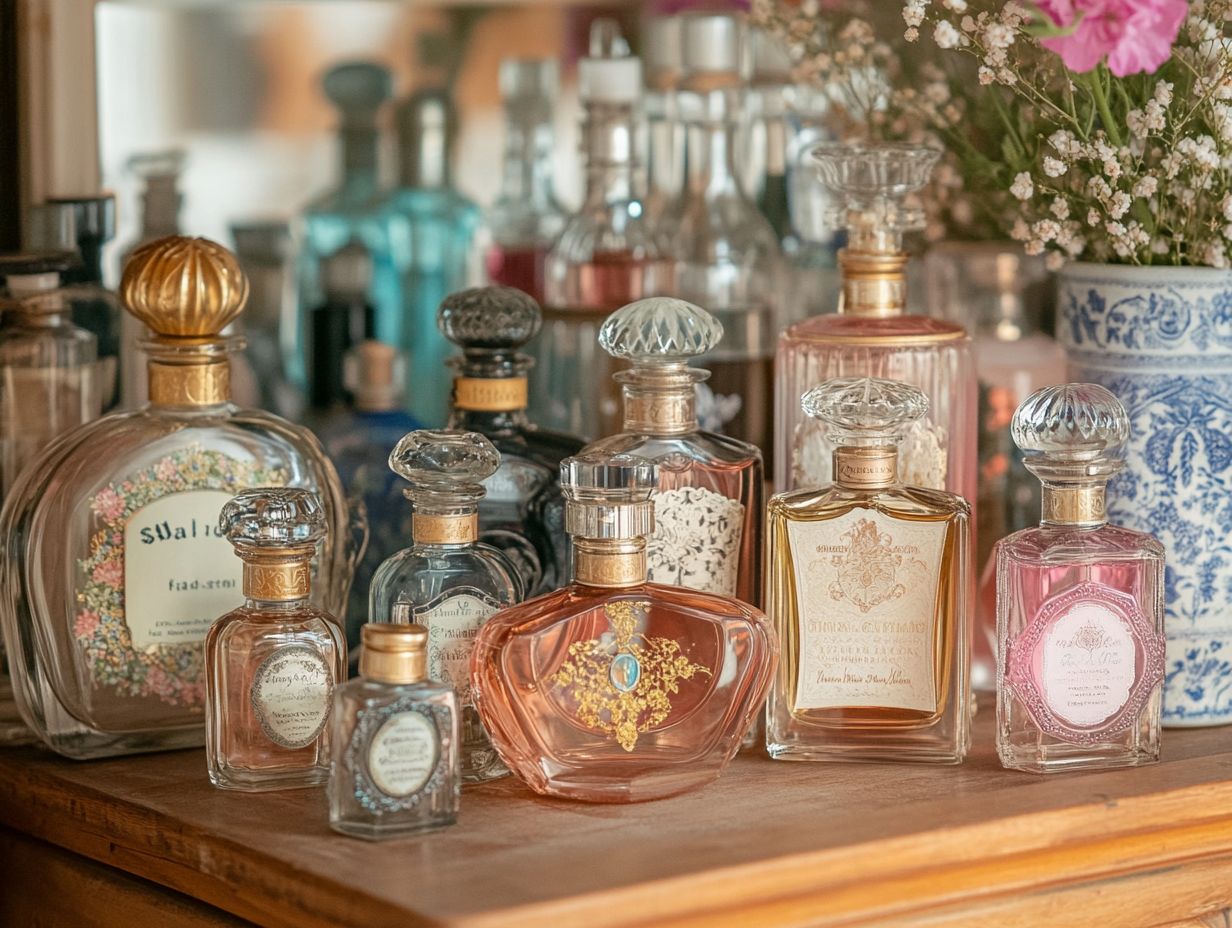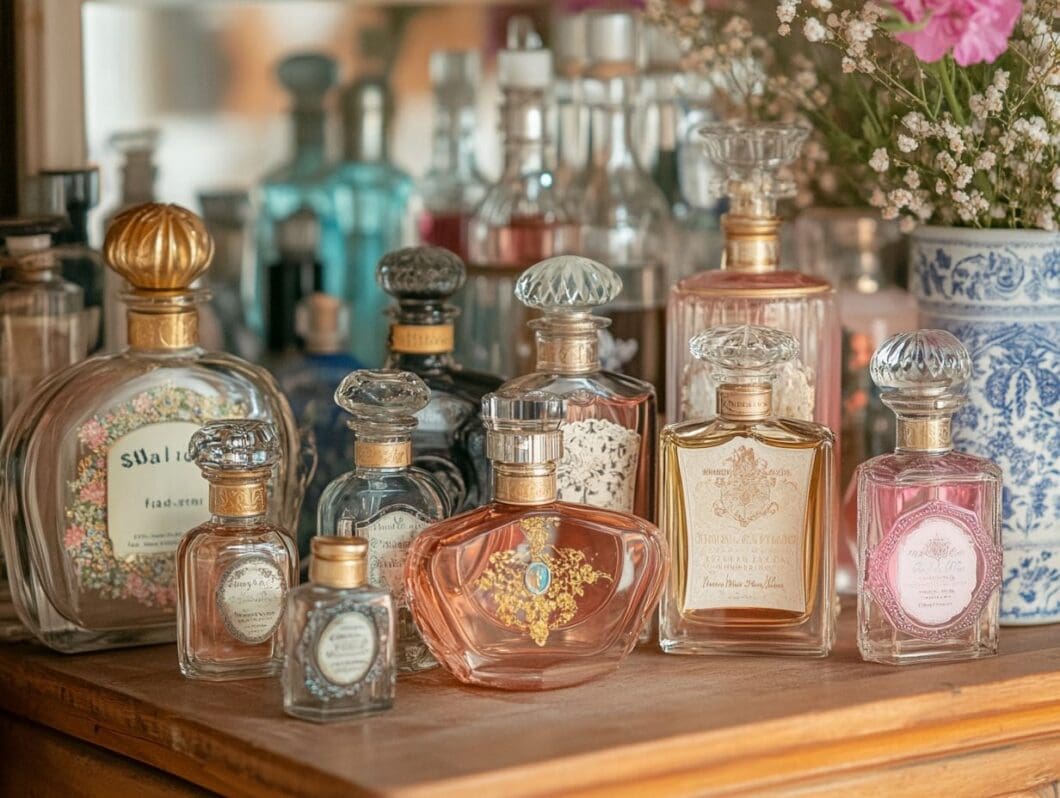Vintage perfumes hold a unique charm, blending history, artistry, and nostalgia in every bottle.
This piece explores the fascinating world of vintage fragrances, from their rich historical roots and evolution to tips for aspiring collectors.
Discover how to identify authentic scents, preserve your treasures, and showcase them beautifully.
Explore iconic vintage perfumes and the stories behind them.
Join us on this aromatic journey that celebrates the art and allure of vintage perfumes.
Key Takeaways:

What are Vintage Perfumes?
Vintage perfumes serve as a distinctive link to the past, encapsulating olfactory memories and a rich heritage of fragrance creation. These collectible bottles frequently showcase iconic brands such as Chanel No. 5, Eau My Sin, and Lanvin, reflecting the artistry and craftsmanship characteristic of their respective eras.
As the fragrance market continues to evolve, perfume collectors are increasingly pursuing these vintage scents, which provide not only nostalgic value but also insight into the history of perfumery. The appeal of these fragrances lies in their complexity, often crafted with essential oils and techniques that have become largely forgotten, making them prized possessions for both dedicated enthusiasts and casual collectors alike.
History of Vintage Perfumes
The history of vintage perfumes represents a captivating journey spanning centuries of fragrance creation, evolving from ancient rituals to modern artistry governed by the regulations of the International Fragrance Association.
In earlier times, scents were primarily derived from natural ingredients, frequently utilized in religious ceremonies or as personal adornments, ultimately leading to the sophisticated formulations recognized today.
This historical evolution mirrors societal changes, technological advancements, and the increasing acknowledgment of perfume as a means of self-expression and luxury.
By examining the timeline of perfume history, one reveals the significant milestones that have defined vintage scents and the artisans responsible for their creation.
Evolution of Perfume Making

The evolution of perfume making has undergone significant transformations, particularly highlighted by the transition from traditional formulas to modern reformulations that address changing consumer preferences.
This dynamic shift illustrates a broader comprehension of scent, as artisans began to experiment with both natural and synthetic materials to create innovative olfactory experiences.
The fragrances of the 1980s, such as the bold Opium and the intricate floral notes of Anaïs Anaïs, established new benchmarks in perfumery. Contemporary perfumers, in turn, have been inspired to investigate even more diverse compositions.
These modern formulations frequently incorporate synthetic notes to achieve enhanced longevity and intensity, resulting in fragrances that not only evoke a sense of nostalgia but also resonate with an evolving audience.
Such advancements have facilitated the development of both signature scents and transient trends, exemplifying the interplay between artistry and technological progress within the perfume industry.
Collecting Vintage Perfumes
Collecting vintage perfumes is a gratifying pursuit that enables enthusiasts to delve into the intricate history of fragrance while acquiring rare bottles and vintage collectibles that convey unique narratives.
For many individuals involved in perfume collecting, the excitement lies not only in the acquisition of these items but also in the search for elusive fragrances and the opportunity to possess a piece of olfactory history.
Vintage perfumes, such as Chanel No. 5 and Eau My Sin, frequently appreciate in value over time, rendering them attractive investment options.
This expanding community of collectors promotes a culture of knowledge sharing, experiences, and strategies for sourcing and preserving these timeless treasures.
Tips for Beginners
For individuals new to the field of vintage perfume collection, it is essential to comprehend the intricacies of the fragrance market and the characteristics that distinguish vintage scents from contemporary options. An effective starting point involves familiarizing oneself with iconic brands and fragrances, such as Chanel No. 5 and Eau My Sin, which provide a robust foundation for any novice collector. For more insights, check out The Art of Collecting Vintage Perfumes.
Engaging with online communities and connecting with fellow enthusiasts, as well as utilizing resources like Basenotes.net, can offer valuable insights into the realm of vintage perfumes and assist in identifying rare bottles that warrant pursuit.
Attention should also be directed toward the historical context and formulation changes that have taken place over the decades, as these factors can significantly impact the scent profiles of vintage fragrances. When considering collectible options, it is important to evaluate aspects such as bottle condition, packaging, and even the popularity of the scent at the time of its release.
Additionally, participating in fragrance exhibitions and local meet-up groups can facilitate networking opportunities and provide direct learning experiences from seasoned collectors. Approaching this journey with curiosity will not only expand one’s knowledge but also deepen appreciation for the art of perfumery.
Building a Collection

Building a collection of vintage perfumes necessitates a strategic approach that combines thorough research, patience, and active participation in perfume auctions to acquire essential vintage collectibles. It is advisable to begin by defining a specific focus—whether it entails particular brands, eras, or scent families—to guide selections and enhance the overall cohesiveness of the collection.
Various platforms for sourcing vintage perfumes, such as online auctions and specialty shops, should be explored, while also considering the significance of each piece within the broader context of perfume history.
Along with concentrating on specific categories, collectors should immerse themselves in the rich histories associated with each fragrance, as these narratives can significantly deepen appreciation for the artistry involved. Engaging with perfume communities or attending local gatherings can provide valuable insights and foster meaningful connections. Furthermore, estate sales and thrift shops should not be overlooked, as they often hold hidden treasures for the discerning enthusiast.
As collectors acquire these cherished items, it is beneficial to document the journey by noting their origins and personal reflections. This practice not only preserves the histories of the fragrances but also enhances the emotional connection with each bottle.
Identifying Authentic Vintage Perfumes
Identifying authentic vintage perfumes is crucial for collectors aiming to acquire genuine pieces that possess both sentimental and monetary value, especially given the prevalence of counterfeits and misrepresented fragrances in the market.
Key indicators of authenticity include the original packaging, label details, and bottle design, all of which can offer insights into a perfume’s true age and origin. Furthermore, discerning collectors can validate authenticity by detecting subtle nuances in the scent and examining the condition of the bottle.
Signs of Authenticity
There are several distinct indicators of authenticity that vintage perfume collectors should consider when evaluating potential acquisitions, ensuring that they invest in genuine vintage fragrances. One of the primary indicators is the condition of the bottle and packaging; while vintage perfumes should display signs of age, they should not exhibit excessive wear. Familiarity with the brand’s historical packaging and labeling can aid collectors in determining whether a scent is genuinely vintage or a modern imitation.
Experts recommend paying close attention to the label, as authentic vintage perfumes often feature specific fonts, colors, and design elements that are characteristic of their respective eras. Additionally, the cap and bottle design can provide valuable insights, as many brands employed distinctive shapes or materials that are no longer in production. It is also advisable to examine the fragrance itself; genuine vintage scents may possess a depth and complexity that modern formulations frequently lack.
To ensure provenance, it is important to verify the history of the bottle; documentation or records of previous ownership can significantly enhance its credibility.
Preserving and Displaying Vintage Perfumes

Preserving and displaying vintage perfumes is essential for maintaining their integrity and enhancing their aesthetic appeal for both perfume enthusiasts and collectors.
Proper storage practices require that fragrances be kept away from direct sunlight, heat sources, and humidity, as these elements can deteriorate scent quality over time. Additionally, displaying collectible bottles in a manner that minimizes exposure to air and light is vital to preserving their original character. This approach allows collectors to appreciate the beauty of these items without compromising their value.
Proper Storage and Maintenance
Proper storage and maintenance of vintage perfumes are essential for preserving their quality and extending their lifespan, enabling collectors to appreciate their exquisite scents for many years.
Along with maintaining a stable temperature, it is important to monitor humidity levels, ideally keeping them between 40-50% to prevent any undesirable changes. Utilizing the original packaging can further protect the fragrances from excessive exposure to air and light, both of which can degrade the essential oils over time.
Bottles should be stored upright to prevent contact between the liquid and the sprayer, as this can lead to oxidation. Additionally, it is crucial to keep vintage fragrances away from areas with strong odors, such as kitchens or laundry rooms, since these external scents may interfere with their delicate compositions.
Popular Vintage Perfumes and Their Stories
Renowned vintage perfumes such as Chanel No. 5, Eau My Sin, and creations from esteemed houses like Dior and Guerlain possess rich histories that often reflect the cultural zeitgeist and the vision of their respective perfumers.
Each fragrance encapsulates a narrative—whether it be the innovative methodology of Sarah McCartney or the timeless elegance exemplified by Chanel—that has captivated fragrance enthusiasts across generations.
Comprehending these narratives not only enhances the collector’s experience but also underscores the artistry and intention inherent in each iconic scent.
Iconic Scents and Their Origins
Iconic fragrances such as Chanel No. 5 and Eau My Sin have become emblematic of vintage perfume history, each providing insight into the artistry and cultural context of their respective eras.
The legacy of these perfumes extends well beyond their initial launch, as they encapsulate the essence of the times in which they were created. For instance, Chanel No. 5 emerged during the Roaring Twenties, an era defined by liberation and bold expression. This fragrance presented a modern approach that was groundbreaking, attracting a new generation of devoted admirers.
In contrast, Eau My Sin challenged societal norms with its provocatively bold character, prompting discourse on femininity and desire. Collectors pursue these masterpieces not only for their olfactory attributes but also for their historical significance, thereby solidifying their status as invaluable treasures within the fragrance community and beyond.


